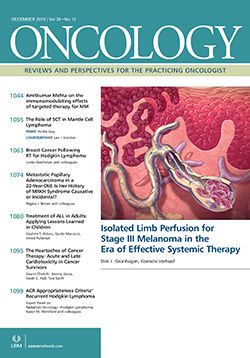New Does Not Always Mean Better: Isolated Limb Perfusion Still Has a Role in the Management of In-Transit Melanoma Metastases
In the recent era of effective systemic therapies for melanoma, the provocative question of whether isolated limb perfusion still plays a role in the treatment of patients with in-transit melanoma metastases is timely and relevant.
Oncology (Williston Park). 30(12):1053–1054.

In the recent era of effective systemic therapies for melanoma, the provocative question of whether isolated limb perfusion (ILP) still plays a role in the treatment of patients with in-transit melanoma metastases is timely and relevant. In their systematic review of ILP treatment considerations and response rates, Drs. Grünhagen and Verhoef provide a balanced assessment of the benefits and drawbacks of regional therapy approaches.[1]
ILP is a venerable therapy with which clinicians have more than 50 years of experience and for which there are measures known to limit the predictable toxicities. It has evolved into an effective modality that produces a complete response (CR) rate of about 60%, with half of those responses being durable. Since ILP is an “old” approach using an “old” chemotherapy agent (melphalan), it is easy to dismiss this technique in favor of emerging state-of-the-art systemic options, including small-molecule inhibitors and checkpoint blockade immunotherapy. In terms of CR rates, ILP remains superior to all other approaches, but is limited to a select group of patients with extremity in-transit melanoma metastases. When considering cost and overall outcome, a single treatment with ILP appears to represent just a fraction of the expenditure associated with systemic therapies that are typically continued for a prolonged period of time, or even indefinitely. The cumulative data presented by the authors emphatically suggests that there is a definite role for ILP in select melanoma patients with regional disease. However, the real question is how to employ ILP, perhaps in combination with other therapies, to either boost in-limb responses or influence systemic recurrence rates and overall survival.
Other than the inclusion of tumor necrosis factor (TNF), replacement chemotherapies or additive agents have been lacking in the field of regional therapies. While the authors provide strong data and a compelling rationale for the use of TNF during ILP, due to an often-criticized clinical trial,[2] TNF is not utilized in this setting in the United States. TNF improves response rates, but patients require close monitoring for systemic leak, which can be profound. Ultimately, drugs designed to take advantage of the hyperthermia and localized delivery characteristic of ILP may prove fruitful, and ILP combinations may represent a unique niche in which to test novel agents for their ability to cause high rates of CR, which would make them potentially interesting for further systemic development.
The combination of ILP and immunotherapy is particularly appealing as a means of influencing disease-free survival and potentially overall survival. Ongoing clinical trials are evaluating the application of anti–cytotoxic T-lymphocyte–associated antigen 4 combined with ILP or isolated limb infusion (ILI) (ClinicalTrials.gov identifiers: NCT02094391 and NCT02115243). Theoretically, these approaches would take advantage of the high rates of in-limb response to treatment with ILP and simultaneously generate a systemic immune response against any occult micrometastases. Accordingly, Grünhagen and Verhoef identify this as an area ripe for research in specialized melanoma centers. For example, the optimal timing of immunotherapy before or after ILP or ILI, the duration of treatments, the potential for synergy and dose reduction, and the unique toxicities encountered are completely unknown. Further, the emergence of other checkpoint inhibitors, small-molecule inhibitors, viral oncolytics (eg, talimogene laherparepvec, known as T-VEC), and other injectable agents (eg, PV-10) is exciting, but new agents need to be incorporated into therapeutic protocols in a rational way.
In their review, Drs. Grünhagen and Verhoef rightly bring attention to the superior results historically achieved with ILP in comparison with the responses seen with current systemic therapies. Overall, the greatest challenges facing clinicians with regard to the treatment of in-transit melanoma metastases are selecting the appropriate patients for a regional therapy approach, and recognizing that ILP still affords unmatched responses despite the building excitement associated with modern systemic therapies.
Financial Disclosure:The authors have no significant interest in or other relationship with the manufacturer of any product or provider of any service mentioned in this article.
References:
1. Grünhagen DJ, Verhoef C. Isolated limb perfusion for stage III melanoma: Does it still have a role in the present era of effective systemic therapy? Oncology (Williston Park). 2016;30:1045-52.
2. Cornett WR, McCall LM, Petersen RP, et al. Randomized multicenter trial of hyperthermic isolated limb perfusion with melphalan alone compared with melphalan plus tumor necrosis factor: American College of Surgeons Oncology Group Trial Z0020. J Clin Oncol. 2006;24:4196-201.
